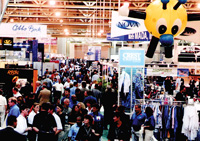No matter how crazy things get amid the Medtrade frenzy, you can always take solace in thinking that "Hey, at least I'm not the one in charge of this thing."
Unless you're Art Ellis.
Not only is Ellis running the show, he has the added pressure of doing it for the first time.
Still, Ellis is no rookie to the trade show production field. Hired in February as VNU Expositions' group vice president for healthcare, he served in a similar capacity for the company in the apparel industry. Moreover, he got a head start on the job by working the Medtrade Spring show in April.
Those experiences serve as the foundation for his pragmatic attitude toward a position that can be relentlessly demanding.
"I'm not approaching it any differently than other jobs I've had," he said. "You surround yourself with top level talent, and I was fortunate to enter a situation where we have that."
A native Chicagoan, Ellis pointed to the 1986 Super Bowl Champion Chicago Bears as an example of how it takes an effective leadership team to get results.
"Mike Ditka is a legendary head coach, but he couldn't have succeeded without guys like [defensive coordinator] Buddy Ryan," he said. "Everyone needs to be on the same page about goals and how to reach them."
Ellis got his professional start in the business-to-business publishing field and spent 20 years at magazines serving the textile and apparel industries before joining VNU in August 2001 as group vice president of apparel trade shows. While some in the trade show production field may feel that one show is no different than the next, Ellis sees Medtrade as serving a special purpose.
"I'm excited to be part of an industry that plays such a vital role in people's lives," he said. "It's rewarding to be associated with a show that is dedicated to this particular segment of healthcare because it is vibrant and growing."
National rankings bear that out, as exposition industry journal Trade Show Week lists Medtrade in its Top 200 trade shows and counts it among the Top 50 fastest growing shows.
Although he comes from outside healthcare, Ellis has done his homework on the industry and is familiarizing himself with Medtrade's principal demographic, the HME provider. Based on what he's learned so far, Ellis realizes that this field is heavily influenced by external factors like government regulation and that Medtrade's purpose goes beyond being simply a product fair.
"While our basic role is to be the mediator between buyers and sellers, it is also our job to keep our ears close to the ground and make sure we're addressing [attendees'] needs so they can survive and grow," he said. "I'm sensing some anxiety out there, but we feel that if we do our jobs, we can relieve that anxiety."
The key to stress relief, Ellis said, is Medtrade's extensive educational component. While long a hallmark of the show, this year's seminar schedule is probably the most ambitious program yet, featuring a variety of day-long workshops on Oct. 17.
"Both AAHomecare and the Medtrade educational planning committee have worked extremely hard to produce the most comprehensive, beneficial conference possible," he said.
Ellis said he understands how high-profile keynote speakers help build a show's attendance, but that the Medtrade audience prefers substance over celebrity. There is much more value in getting a top CMS official than a renowned Hollywood entertainer, he said.
"For the price it takes to bring in a marquee name, I'd rather stand at the door and give each person five bucks," Ellis said.
Medtrade continues to be a venue for commercial transactions, though Ellis acknowledges that the level of purchasing at the show has tapered off in recent years. Conversely, Medtrade's reputation as a showplace for new technology has grown and serves as a major drawing card.
"At-show purchasing may be down, but the level of influence Medtrade plays hasn't changed," Ellis said. "Shopping habits have been affected by the rise of group purchasing and year-round buying cycles. People now come to the show primarily to see the innovations, which ultimately influences their purchasing decisions."
With more than 900 exhibitors on nearly 300,000 square feet of floor space, Medtrade is indeed a gigantic show. Some would even say it's too big, though Ellis dismisses that notion - for now.
"We don't hear too many complaints about the show's size, but in previous years when the show was in different halls, it did get confusing," Ellis said. "Now that the show is in one hall at the Congress Center, it's much more accessible. But it is true that a show can get too big and we have to be wary of that."
After being in Orlando last year, Medtrade is back in its birthplace of Atlanta for 2005 and 2006, which Ellis concedes is popular with exhibitors because there are no theme parks to lure attendees away. Would VNU consider relocating the show to Atlanta permanently?
"I wouldn't rule it out," he said. "But there are various factors that go into the decision of where to locate and we have to consider all of them carefully."




Comments